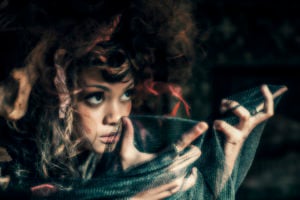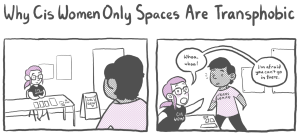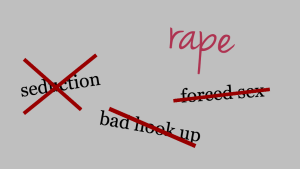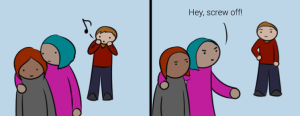
A witch casts a spell.
Originally published on The Establishment and republished here with their permission.
The sleepovers I attended as a little kid all followed a similar pattern: We would have dinner, retreat to the family room to watch whatever movies had been rented for us, consume enormous amounts of soft drinks, and then, riding that sugar high, stay up into the wee hours of the morning giggling over anything and everything.
This routine continued until shortly before we hit puberty – at which point our sleepovers took a darker turn.
As soon as the rest of the family was in bed, we would abandon the family room and whatever embarrassingly babyish movie had been provided for our entertainment and instead make a beeline for the basement.
There, in the chill darkness lit by a single dangling light bulb, we would try to do magic.
Our forays into the dark arts never went further than the most standard of supernatural party tricks: daring each other to invoke Bloody Mary, asking the Ouija boards about our futures, taking turns levitating each other using the old “light as a feather, stiff as a board” game.
Sometimes we tried to cast spells or make effigies of our frenemies; one girl had an older sister who was Wiccan, and we would pore over her books and notes whenever we got the chance. We lit pink candles and chanted the names of boys we liked, hoping to magically persuade them to like us back.
Altogether, it was all pretty harmless, although at the time, those sleepovers hit that perfect sweet spot between thrilling and terrifying.
I realize now that my friends and I weren’t alone in our attempts to practice witchcraft.
In fact, most of the women I’ve talked to have had similar experiences – in some senses, it almost feels like a girlhood rite of passage.
Certainly, the tradition has a rich history.
To pick a very famous example, consider the story of Betty Parris and Abigail Williams, whose accusations of witchcraft sparked the Salem Witch Trials. Ten-year-old Betty and her older cousin Abigail would meet up with other young girls in Salem to practice what they called “little sorceries.”
Most of their activities centered around divining who their future husbands would be, because for a 17th century girl, the greatest indicator of how your life would play out was who you married and which social status you achieved through that marriage.
To find this out, the girls used a device called a “Venus glass” to perform a type of oomancy – in this case, dripping the white of an egg into a glass of water. By watching the shape the egg white took, the girls hoped to find clues about their futures.
While fortune-telling might seem to be at odds with the conservative form of Christianity practiced by the Puritans, the truth is that folk magic – or, as they called it, “white magic” – was frequently (if secretly) practiced by women in early American Puritan communities.
In fact, when Betty and Abigail began to experience strange fits and other signs of bewitchment – signs which appeared, interestingly enough, shortly after they’d been playing at sorcery – one of the first remedies tried was a bit of folk magic called a witch’s cake.
This cake, which was suggested by the girls’ neighbor Mary Sibley, was made of rye flour mixed with urine from the afflicted girls. The cake was then fed to a dog with the hope that the dog’s behavior would somehow reveal the identity of the person bewitching the girls.
Although the intentions behind the witch cake were noble, when Betty’s father, the Reverend Samuel Parris, found out about it, he took to his pulpit to denounce Mary Sibley, calling the witch’s cake “diabolical.”
Mary Sibley immediately confessed and repented. Had she not, she would likely have been among those convicted and executed for witchcraft.
From this story and the story of Betty and Abigail and their friends practicing divination, we can conclude two things: firstly, that charms and spells and other types of folk magic were commonly used even in strict Puritan communities; and secondly, that no matter how “white” the magic was, the women who performed it were always suspected of evil.
In the 300 years that have elapsed since the Salem Witch Trials, our preoccupation with witches hasn’t waned.
We’re just as fascinated by witches as our ancestors – perhaps even more so. Certainly the past few years have seen a resurgence of witches in pop culture.
These days, the terms witch or witchy cover a broad spectrum of things – it might mean someone who practices witchcraft (who may or may not align with a particular pagan or neopagan religion), but then again, it might not.
In some ways, 2017’s version of “witchy” might seem to refer to more of an Instagrammable aesthetic choice than anything else – wearing dark lipstick and crystal pendants, growing cute kitchen herb gardens, and arranging household altars of dried flowers and animal skulls.
It’s tempting to write these things off as being merely superficial affectations, but to do so would be a grave underestimation.
Beneath all that glossy packaging hums the same idea that has tantalized girls, women, and femmes for millennia: the fact that to be a witch is to be someone with power in a world where they are often otherwise powerless.
On some level, all of the contemporary trappings of witchiness tap into that desire to feel powerful.
Black or dark purple lipstick might currently be en vogue, but on some level, they subvert traditional feminine beauty standards and the ability to subvert or reject the status quo often confers a sense of power.
To grow your own herbs and have some knowledge of herblore are powerful in the sense that the ability to provide for yourself – even on a small scale – is a type of power.
And, of course, the idea that setting out a particular arrangement of objects in a particular way with the intent of influencing real-life events is a type of power.
According to Ayşe Tuzlak, who has a PhD in religion and specializes in gender and ritual in the ancient world, it was women’s inability to obtain power through established means and their subsequent attempts to access it through other channels that informed western ideas of what it meant to be a witch:
“European Christian women in late antiquity and the Middle Ages were generally barred access to institutional power, and thus women who expressed their religiosity in unapproved ways, or in ways that were ‘too feminine’ by the standards of the culture, were branded as witches or heretics. The institutions of that time and place had certain assumptions about appropriate behavior for men and women, and what was considered real Christianity and what was not.
“Thus the people who had a vested interest in those institutions began to pay neurotically close attention to anything that looked ‘too feminine,’ and expanded the significance of feminine symbols – like the broom, an ordinary domestic tool – to include dangerous associations, for example flying at night to secret meetings. Because if a woman looked like she was seizing spiritual power that wasn’t hers by right, then everything ‘feminine’ about her [became] suspect and morally charged.
Witch is a highly gendered term, and like most such terms, its masculine counterparts – terms like wizard, warlock, sorcerer, or mage – do not quite mean exactly the same thing.
This is not to say that witches are never men or non-binary people, or that they have never been killed for practicing witchcraft, but rather that the vast bulk of those accused of being witches have been perceived to be women.
Tuzlak explains that just as the term slut – a term so gendered that people will often say “man-slut” if they are using it to refer to a man – says more about how a woman is viewed than it does about her sexual history, so too does the historical use of witch tell us more about how well a woman fit into contemporary gender roles than it does about her actual use of magic:
“I tend to see ‘witch’ as a social category imposed upon a woman who doesn’t fit acceptable religious categories. Which is why I usually put words like ‘witchcraft’ in scare-quotes; for me the word ‘witch’ is kind of like the word ‘slut,’ in that it’s a way to mark a woman as unacceptable and Other, rather than an objective measure of her religion or her sexual behavior.
“Just as you can’t tell how much sex a woman actually has by how often she’s called a slut, so also you can’t really tell anything about a woman’s religion based on whether a priest or a neighbor calls her a witch. And some women who have lots of sex or heretical opinions might pass under the radar because they can perform social acceptability in other ways.
Given all of that, what exactly does witch mean?
The term walks that tricky knife’s edge of a slur that has been reclaimed by some of the people it might be used against.
How do we figure out how to balance the fact that witch is both an accusation that has been historically deadly, and also an identity that many find empowering?
For Tuzlak, the answer lies in understanding the place the witch has traditionally occupied in cultural hierarchies:
“I tend to understand things in terms of power structures and insider/outsider status with regard to institutions.
“So, to use our own culture as an example, if someone offers me drugs in a carpeted office, neatly groomed, wearing a white lab coat, with a name tag that says Dr. Something on it, then I will probably assume that that person has my best interests at heart and that the drugs [they are] giving me are going to help me (even though none of those things are necessarily true).
“If someone [offers me drugs in another scenario, like at a party], I will likely assume that the drugs are ‘just for fun,’ and that the person is…not especially committed to my well-being (though none of those things might be true either).
“There are lots of shades of gray between these two extremes of licit and illicit, too – the friend of a friend who can get you weed, the naturopath who advertises in the back of a new age magazine, your auntie who’s just really good at helping pregnant women with their morning sickness, the not-quite-legal-but-never-really-busted dispensary, the friend who’s not taking Lyrica any more and gives you the rest of her scrip when you’re hard up.
“Assuming we’re talking about ‘real’ witches here (i.e., not just someone who’s accused of witchcraft by an inquisition, but a local wise woman or healer), I see the witch’s work as falling on a similar spectrum. She is clearly not offering the ‘official’ help that a physician or priest would, which brings with it a lot of risks, but which also allows someone to work outside a system that doesn’t necessarily offer her what she needs. I think the ‘witch’ in this sense is a crucial contribution to the social health of a culture, especially a culture that is under the heel of powerful institutions that do not take women or other marginalized groups seriously.
And yet it’s hard not to notice that as much as the idea of the witch subverts traditional gender roles, it also, in some ways, upholds them.
This is especially apparent in our modern take on the witch, especially when it comes to the Neopagan movement, a set of modern pagan religions of which Wicca is the most well-known.
Many practices and beliefs in various sects of Neopaganism can be very rigid and cisnormative in their treatment of gender, and this, of course, has the unfortunate consequence of perpetuating gender stereotypes. As Tuzlak puts it:
“The image of the ‘witch’ can be both liberating and oppressive to women, very often at the same time. The history of modern witchcraft makes gendered language very hard to escape.
“Keep in mind that most of the primary branches of Neopagan practice were shaped by men, which means that Gardnerian/Alexandrian/Crowleyan constructions of masculinity and femininity arise out of very conservative views on gender, in line with the assumptions of 19th-century English esotericists and the medieval/early modern texts they were working with. As a result, a lot of introductory magic textbooks talk in a very uncritical way about the ‘masculine’ sun and the ‘feminine’ moon, ‘masculine’ fire and ‘feminine’ water, and so on.
“That said, Gardnerian and Alexandrian branches aren’t all there is, and there were smart, bad-ass, complicated women like Helena Blavatsky, Dion Fortune, and Doreen Valiente involved even in the earliest stages of modern witchcraft, and in the past few decades there has been a move to make Neopaganism more intersectional and queer.”
It’s not hard to understand why witches and witchcraft continue to hold sway over women and femmes – especially young women on the cusp of adulthood who are faced with a world that refuses to take them seriously except as sexual objects.
Not only has witchcraft historically offered women power that they might not otherwise be able to access, but witches offer girls, women, and femmes an alternative role model to the ubiquitous young, beautiful Disney princess.
A witch can be any age; a witch does not need to be conventionally attractive; a witch does not wait for a prince charming, nor does she rely on anyone but herself.
Given that, the witch’s appeal is easy to appreciate.
Tuzlak theorizes that young women’s attraction to witchcraft goes beyond even that and taps into our deep-seated need for ritual:
“[Children] can be badly wounded by traditional Christian or Anglo-American gender roles, especially if they’re queer or trans or otherwise ill-fitting to those roles, and girls are going to suffer more acutely if the family is more reactionary in its politics. Magic is an unofficial shortcut to a feeling of spiritual power and belonging when legitimate methods have been closed off to you, and that happens to girls more often and more traumatically than boys in our culture.
“But I think that magic appeals to a lot of people who feel like they’re out of place in their local religious or social landscape. I don’t think Christian rituals (at least in many white/mainline/evangelical/Protestant churches – Christianity is very diverse and I do not like generalizing) serve young people very well, and I don’t think they serve young girls well in particular, which is another reason why young people find ways to fulfil their ritual needs elsewhere. There are so few formal, public rituals that recognize and affirm girls.”
It’s impossible to say where witchcraft will go from here or what “witchy” will look like a century or two from now.
What seems certain is that as long as our society remains invested in hierarchical power structures that function by excluding certain groups of people, then those outsiders will continue to look for other things that fulfill their needs.
And so long as the tradition of the witch exists, those who struggle to find legitimacy in traditional power structures will almost certainly be drawn to witchcraft – whatever that word or practice might mean to them.
Because as much as we might try to define what a witch’s identity or actions, the truth is that the term is much broader than any one definition can contain.
Or perhaps it is easier to simply say that a witch is someone who, when faced with a brick wall, learns to dig a tunnel.
A witch is a survivor, and witchcraft is a means of survival in a world that does not always value your life.
***
For more from The Establishment, check out:
- The Pains Of Being Woke
- Why Are We Scared To Admit That Pregnancy And Childbirth Can Be Sensual?
- The Dangers Of The ‘Cool Girl’ Ideal
[do_widget id=’text-101′]
Anne Thériault is a Toronto-based writer and cat enthusiast who blogs about feminism, mental health, and parenting. You can follow her on Twitter at @anne_theriault or on her blog, The Belle Jar.
Search our 3000+ articles!
Read our articles about:
Our online racial justice training
Used by hundreds of universities, non-profits, and businesses.
Click to learn more




















